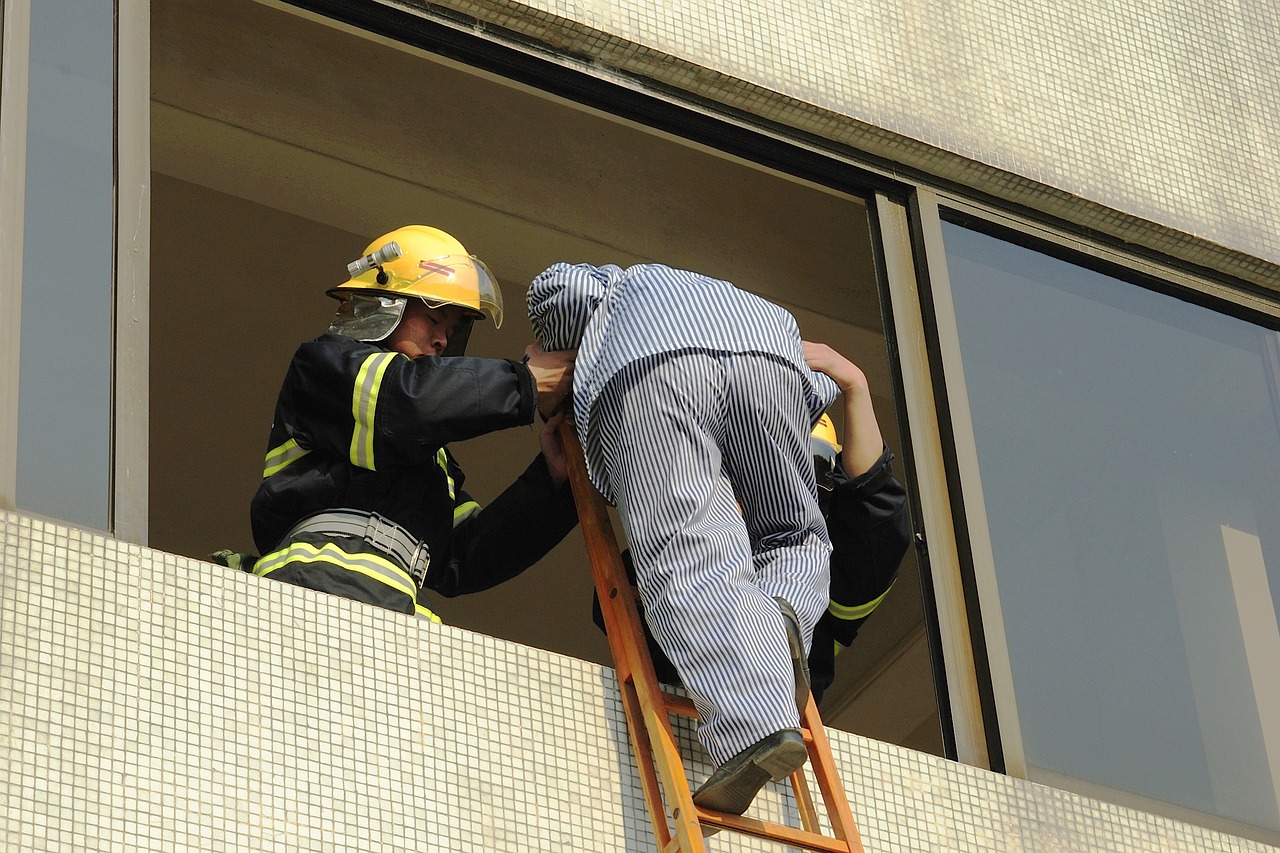Human Behavior: The Backbone of Effective Safety Measures
When we talk about safety measures, we often think about protocols, equipment, and regulations. However, the real key player in this arena is something much more complex: human behavior. Understanding how people think, feel, and act is essential for any safety protocol to be truly effective. It’s like trying to navigate a ship without understanding the wind’s direction; you might have the best sails, but without that knowledge, you’re likely to drift off course.
In various environments—be it a construction site, a hospital, or even an office—human behavior significantly influences safety outcomes. This article aims to dive deep into the psychological factors that drive safety compliance, the impact of human error, the critical role of communication, and how we can cultivate a robust safety culture. By grasping these elements, organizations can not only enhance their safety protocols but also foster an environment where safety becomes second nature.
Consider this: every year, countless accidents occur not because of faulty equipment or outdated procedures, but due to simple human errors. These can stem from distractions, miscommunications, or a lack of understanding. Thus, it becomes imperative to explore how we can bridge the gap between human behavior and safety measures. By doing so, we can create a safer environment for everyone involved.
In the following sections, we will dissect the intricate relationship between human behavior and safety, focusing on the psychological underpinnings that influence how individuals respond to safety protocols. We’ll also look at the various types of human errors that can occur and how organizations can implement effective training and awareness programs to mitigate these risks. Ultimately, the goal is to understand that safety is not just a checklist but a culture that thrives on awareness, communication, and engagement.
Understanding the psychological factors that influence safety compliance is essential for developing effective safety measures. This section will delve into motivation, perception, and the importance of a safety culture.
Human error is a significant contributor to safety incidents. This section will analyze common types of errors, their causes, and how organizations can mitigate their effects through training and awareness.
Identifying the various types of human errors can help organizations tailor their training programs. This subsection will categorize errors into slips, lapses, and mistakes, providing examples of each.
Slips and lapses occur when individuals fail to execute known procedures. This subsection will discuss how distractions and memory failures contribute to these errors in safety-critical environments.
Mistakes often arise from poor judgment or lack of information. This subsection will explore how decision-making processes can be improved to minimize mistakes in safety-related situations.
Effective training and awareness programs can significantly reduce human error. This subsection will highlight best practices for designing and implementing these programs to enhance safety compliance.
Effective communication is vital for promoting safety. This section will examine how clear communication can prevent misunderstandings and foster a culture of safety within organizations.
Identifying barriers to effective communication is crucial for improving safety. This subsection will address common obstacles such as language differences, hierarchical structures, and information overload.
Implementing strategies to enhance communication can lead to better safety outcomes. This subsection will provide actionable tips for fostering open dialogue and feedback within teams.
Establishing a strong safety culture is essential for long-term safety success. This section will discuss the components of a safety culture and how organizations can cultivate it among employees.
Leadership plays a pivotal role in shaping safety culture. This subsection will explore how leaders can model safe behaviors and promote accountability within their teams.
Engaging employees in safety initiatives fosters a sense of ownership. This subsection will discuss methods for encouraging participation and feedback from employees to strengthen safety measures.
- What is the most common cause of human error in safety incidents?
Distractions and lack of proper training are often cited as leading causes of human error in safety incidents.
- How can organizations improve their safety culture?
By fostering open communication, providing regular training, and engaging employees in safety initiatives.
- What role does leadership play in safety?
Leaders set the tone for safety culture by modeling safe behaviors and holding team members accountable.

The Psychology of Safety Compliance
Understanding the psychological factors that influence safety compliance is essential for developing effective safety measures. At the core of this understanding lies the concept of motivation. Why do people follow safety protocols? Is it merely to avoid penalties, or is there a deeper, intrinsic desire to ensure their own safety and that of their colleagues? Research indicates that when individuals feel personally invested in their safety, compliance rates soar. This sense of ownership transforms safety from a mere obligation into a shared value, fostering a culture where everyone actively participates in maintaining safety standards.
Perception also plays a crucial role in safety compliance. How employees perceive risks can dramatically affect their behavior. For instance, if a worker views a particular task as low-risk, they may be less inclined to adhere to safety protocols. This perception can stem from various factors, including past experiences, training, and even organizational culture. Therefore, organizations must actively work to shape perceptions around safety, ensuring that all employees recognize the potential hazards associated with their tasks.
Moreover, creating a strong safety culture is not just about enforcing rules; it’s about embedding safety into the very fabric of the organization. A safety culture is characterized by open communication, where employees feel comfortable voicing concerns and suggesting improvements. This environment encourages individuals to prioritize safety, as they understand that their input is valued. When safety becomes a collective responsibility, compliance naturally follows.
To illustrate the importance of these psychological factors, consider the following table that summarizes key elements influencing safety compliance:
| Element | Description | Impact on Compliance |
|---|---|---|
| Motivation | Intrinsic desire to ensure safety and well-being | High compliance when employees feel ownership |
| Perception | How risks are viewed based on past experiences and training | Compliance varies with risk perception |
| Safety Culture | Shared values and practices around safety within the organization | Strong culture leads to higher compliance and proactive behavior |
In conclusion, understanding the psychology behind safety compliance is not just an academic exercise; it’s a vital component of effective safety measures. By addressing motivation, perception, and fostering a robust safety culture, organizations can significantly enhance their safety protocols. Remember, safety isn't just about rules—it's about people and their behaviors. The more organizations invest in understanding the psychological aspects of safety, the better equipped they will be to protect their employees and create a safer work environment.

Human Error and Its Impact on Safety
Human error is often cited as a leading cause of safety incidents across various industries, and understanding its nuances is crucial for effective safety management. Imagine you're driving a car; a momentary distraction, like a text message, could lead to a serious accident. This analogy illustrates how even a brief lapse in attention can have significant consequences. In workplaces, similar errors can lead to catastrophic results, affecting not just the individual but also their colleagues and the organization as a whole.
Errors can generally be categorized into three main types: slips, lapses, and mistakes. Each type has its unique characteristics and implications for safety protocols. Slips often occur during routine tasks when an individual fails to execute a known procedure correctly. For instance, a worker might forget to wear protective gear because they were distracted by a conversation. Lapses, on the other hand, are memory failures where an individual simply forgets a critical step, such as failing to lock a safety valve after maintenance work.
Mistakes are a bit more complex; they arise from poor judgment or a lack of information. For example, a manager might make a decision to cut corners on safety measures to save time, believing that the risks are minimal. Such decisions can have dire consequences, highlighting the need for a robust decision-making process that incorporates safety considerations at every level.
| Error Type | Description | Example |
|---|---|---|
| Slips | Execution failures during routine tasks. | Forgetting to wear a helmet on a construction site. |
| Lapses | Memory failures leading to missed steps. | Neglecting to check safety equipment before use. |
| Mistakes | Poor judgment or lack of information. | Choosing not to follow safety protocols due to time pressure. |
Organizations can significantly mitigate the effects of human error through comprehensive training and awareness programs. These initiatives should focus on not only the technical skills required for the job but also the psychological aspects that contribute to errors. By fostering an environment where employees feel comfortable discussing their mistakes without fear of reprisal, organizations can enhance learning and improve safety protocols. After all, a culture that encourages open dialogue and continuous improvement is less likely to experience the devastating effects of human error.
- What are the most common causes of human error in safety-critical environments? Distractions, lack of training, and poor communication are among the leading causes of human error.
- How can organizations reduce human error? Implementing comprehensive training programs, encouraging open communication, and fostering a culture of safety can help reduce human error.
- Are all human errors preventable? While not all errors can be eliminated, many can be significantly reduced through awareness and training.

Types of Human Errors
Understanding the various types of human errors is crucial for organizations aiming to enhance their safety protocols. Human errors can generally be categorized into three main types: slips, lapses, and mistakes. Each of these errors stems from different cognitive processes and situations, making it essential for safety training programs to address them specifically. By identifying these categories, organizations can tailor their training programs to mitigate risks effectively.
Slips occur when individuals fail to execute known procedures correctly. Imagine a seasoned pilot who has flown the same route dozens of times. One day, distracted by a conversation with a co-pilot, he forgets to adjust the altimeter. This momentary lapse in focus can lead to significant safety risks. Slips often happen in high-pressure environments where multitasking is common. According to research, distractions can lead to a 30% increase in slip-related incidents. Therefore, organizations should implement strategies to minimize distractions, such as creating a more focused work environment.
Lapses, on the other hand, are memory-related failures. For instance, a nurse may forget to check a patient's allergy history before administering medication. This type of error often results from cognitive overload or stress. When individuals are overwhelmed with information or tasks, their brains can fail to recall critical details. Organizations can combat lapses by simplifying procedures, providing checklists, and encouraging regular breaks to help employees maintain their focus and memory capacity.
Finally, we have mistakes, which arise from poor judgment or a lack of information. For example, a construction manager may decide to proceed with a project without adequate safety assessments, believing that the risks are manageable. This kind of error often stems from insufficient training or a lack of experience. To reduce mistakes, organizations should invest in comprehensive training programs that cover decision-making skills and risk assessment. By fostering a culture of continuous learning, employees will be better equipped to make informed decisions.
To summarize, recognizing the different types of human errors—slips, lapses, and mistakes—allows organizations to create targeted training and awareness programs. Each category presents unique challenges, but with the right strategies in place, organizations can significantly enhance their safety measures and reduce the likelihood of incidents.
- What are the main types of human errors? The main types of human errors are slips, lapses, and mistakes. Each type has different causes and requires specific strategies for mitigation.
- How can organizations reduce human errors? Organizations can reduce human errors by implementing targeted training programs, simplifying procedures, and fostering a culture of safety and continuous learning.
- What role does distraction play in human errors? Distractions significantly increase the likelihood of slips and lapses, as they can lead to missed steps or forgotten information during critical tasks.

Slips and Lapses
When we talk about safety in any environment, whether it’s a bustling construction site or a quiet office, are often the silent culprits behind many incidents. These errors occur during routine tasks, where individuals fail to execute known procedures correctly. Imagine you’re driving a car and suddenly realize you’ve missed your turn because you were lost in thought. That’s a classic example of a slip—a momentary lapse in attention that can lead to significant consequences.
Slips typically happen when our brains are overloaded or distracted. In high-pressure environments, like healthcare or manufacturing, even the smallest distraction can lead to a slip. For instance, a nurse might accidentally administer the wrong dosage of medication simply because she was interrupted mid-task. Similarly, in a factory, an operator might forget to follow a safety protocol due to noise or interruptions from colleagues. These situations highlight how environmental factors can significantly impact our ability to focus and perform tasks correctly.
On the other hand, lapses are more about memory failures. When we lapse, we forget to do something that we know we should. For instance, a technician might forget to check a safety gauge before starting machinery. This isn’t because they don’t know the procedure; rather, it’s a moment where their mind wanders or they become preoccupied with other thoughts. To illustrate this further, here are some common causes of slips and lapses:
- Distractions: External factors that draw attention away from the task at hand.
- Fatigue: Tiredness can significantly reduce cognitive function and increase the likelihood of errors.
- Complexity of tasks: The more complicated a task, the higher the chance of making a mistake.
To combat slips and lapses, organizations must create an environment that minimizes distractions and promotes focus. Simple strategies can make a big difference, such as:
- Implementing checklists to ensure all steps are followed.
- Providing regular breaks to reduce fatigue.
- Encouraging a culture where team members can remind each other of safety protocols without hesitation.
In conclusion, understanding the nature of slips and lapses is crucial for any organization aiming to enhance safety. By recognizing these errors as part of human behavior, we can better prepare our teams to mitigate their effects and foster a safer working environment. After all, safety isn’t just about rules and regulations; it’s about understanding the people who follow them.
Q: What is the difference between a slip and a lapse?
A: A slip is a failure to execute a known procedure correctly, while a lapse is a memory failure where an individual forgets to perform a task they know they should.
Q: How can organizations reduce slips and lapses?
A: Organizations can reduce these errors by minimizing distractions, providing regular breaks, and implementing checklists to ensure all safety protocols are followed.
Q: Are slips and lapses avoidable?
A: While it’s impossible to eliminate them completely, understanding their causes and creating a supportive environment can significantly reduce their occurrence.

Mistakes in Decision-Making
When it comes to safety, making the right decisions is absolutely crucial. However, mistakes in decision-making are all too common, and they can have dire consequences. These mistakes often stem from various factors such as cognitive biases, lack of information, or even the pressure of time constraints. Imagine being in a high-stakes situation where every second counts; the pressure can lead to snap judgments that may not be the best choice. It’s like trying to solve a puzzle with missing pieces—without complete information, how can one make an informed decision?
One common type of mistake arises from overconfidence. When individuals believe they have all the answers, they may overlook critical details or dismiss alternative viewpoints. This can lead to a false sense of security, where they assume everything will go smoothly. In safety-critical environments, this can be particularly dangerous. For instance, a supervisor might decide to skip a safety check because they feel confident in their team's abilities, only to discover a significant oversight later on.
Another factor contributing to decision-making mistakes is information overload. In today’s fast-paced world, we are bombarded with data from multiple sources. This can overwhelm individuals and lead to paralysis by analysis. They may struggle to sift through the noise to find the relevant information needed to make an effective decision. It's like trying to find a needle in a haystack—without a clear strategy, the right choice can easily get lost amidst the clutter.
Moreover, the environment plays a significant role in decision-making. High-stress situations can cloud judgment and lead to hasty decisions. For example, during an emergency, individuals might react based on instinct rather than a well-thought-out plan. This instinctual response can sometimes save lives, but it can also lead to mistakes if the situation is misunderstood. Therefore, organizations must create an environment where employees feel safe to take their time and consult with others before making decisions.
To mitigate these decision-making errors, organizations can implement several strategies:
- Encourage collaborative decision-making to gather diverse perspectives and insights.
- Provide training programs focused on critical thinking and problem-solving skills.
- Establish clear protocols for decision-making processes, especially in high-pressure situations.
In conclusion, understanding the common mistakes in decision-making is vital for enhancing safety protocols. By recognizing the potential pitfalls and implementing strategies to address them, organizations can significantly reduce the risk of safety incidents. Remember, in the realm of safety, every decision counts, and taking the time to make informed choices can make all the difference.
- What are the most common mistakes in decision-making related to safety?
Common mistakes include overconfidence, information overload, and making hasty decisions under stress. - How can organizations improve decision-making processes?
Organizations can enhance decision-making by encouraging collaboration, providing training, and establishing clear protocols. - Why is understanding human behavior important in safety measures?
Understanding human behavior helps organizations tailor safety protocols to address psychological factors that influence compliance and decision-making.

Training and Awareness Programs
When it comes to enhancing safety compliance, are your best friends. Think of them as the sturdy bridge connecting the gaps between knowledge and action. It's one thing to know the safety protocols, but it's entirely another to put them into practice consistently. Effective training programs not only equip employees with the necessary skills but also cultivate a mindset geared towards safety.
To design a successful training program, organizations should consider several key components. First and foremost, the program should be tailored to fit the specific needs of the workplace. This means assessing the unique risks associated with different roles and developing content that addresses those risks directly. For instance, a construction site may require different training than a corporate office. By customizing the training, employees are more likely to relate to the material, making it easier for them to absorb and retain critical information.
Moreover, incorporating a variety of training methods can significantly enhance engagement. Instead of relying solely on traditional lectures, organizations should consider using interactive elements such as workshops, simulations, and e-learning modules. These methods not only keep participants engaged but also allow them to practice skills in a safe environment. For example, a simulation can mimic real-life scenarios, giving employees the chance to apply their knowledge without the risk of actual harm.
Another crucial aspect is the ongoing nature of these programs. Safety training should not be a one-time event but rather a continuous process. Regular refresher courses and updates on new safety protocols can help keep safety at the forefront of employees' minds. Additionally, organizations can utilize feedback mechanisms to assess the effectiveness of their training. Gathering input from participants can provide valuable insights into areas that may need improvement, ensuring the program evolves with changing safety standards and workplace dynamics.
One of the most effective ways to enhance awareness is through real-life case studies. Sharing stories of incidents—both near misses and accidents—can have a profound impact on employees. When individuals see the real consequences of safety lapses, it can serve as a wake-up call, reinforcing the importance of compliance. Moreover, recognizing and celebrating safe behaviors can also motivate employees to take ownership of their safety responsibilities. By fostering an environment where safety is valued and rewarded, organizations can cultivate a culture of proactive safety awareness.
In summary, well-structured training and awareness programs are crucial for minimizing human error and enhancing safety compliance. By tailoring content, using diverse training methods, ensuring ongoing education, and sharing real-life experiences, organizations can create a robust safety culture that empowers employees to prioritize safety in their daily routines.
- What is the primary goal of safety training programs?
The primary goal is to equip employees with the knowledge and skills necessary to identify hazards and adhere to safety protocols, ultimately reducing the risk of accidents. - How often should safety training be conducted?
Safety training should be conducted regularly, with refresher courses at least annually, or whenever there are significant changes in procedures or regulations. - Can training programs be customized for different roles?
Absolutely! Customizing training programs to address specific risks associated with different roles enhances relevance and engagement. - What are some effective training methods?
Effective methods include interactive workshops, simulations, e-learning modules, and real-life case studies.

The Role of Communication in Safety
Effective communication is not just a nice-to-have in any organization; it is the very backbone of promoting safety. When we think about safety in the workplace, we often picture hard hats, safety goggles, and warning signs. But what about the conversations that happen—or don’t happen—between employees? Poor communication can lead to misunderstandings that could potentially jeopardize safety. Imagine a scenario where a critical safety procedure is not clearly conveyed. It’s like trying to navigate a maze blindfolded; the chances of hitting a wall are significantly higher. This is why understanding the role of communication in safety is crucial.
Clear, concise communication can prevent accidents before they happen. It fosters an environment where everyone feels comfortable voicing concerns or reporting unsafe practices without fear of repercussions. In fact, a study by the National Safety Council found that organizations with open communication channels experience fewer incidents. This is because employees are more likely to report hazards when they know their voices are heard. So, how do we ensure that communication is effective?
Firstly, it’s essential to establish a common language. In diverse workplaces, language differences can create barriers to effective communication. When team members don’t speak the same language fluently, vital safety information can get lost in translation. Organizations should consider providing language training or utilizing visual aids, such as infographics or videos, to convey safety messages. This approach not only makes information accessible but also reinforces the importance of safety protocols.
Secondly, hierarchical structures can stifle communication. Employees at lower levels may hesitate to speak up, fearing that their concerns will be dismissed by management. To combat this, organizations should encourage a culture of openness where all employees, regardless of their position, feel empowered to share their thoughts. Regular safety meetings can serve as a platform for open dialogue, allowing everyone to contribute ideas and discuss safety issues. Think of it as a safety roundtable; everyone has a seat at the table, and every voice matters.
Moreover, information overload can be a significant barrier to effective communication. When employees are bombarded with too much information at once, critical safety messages can get lost. To counteract this, organizations should prioritize clarity and simplicity in their communication. Using bullet points or highlighting key information can help ensure that essential safety messages stand out. For example:
- Always wear personal protective equipment (PPE).
- Report any unsafe conditions immediately.
- Participate in safety drills regularly.
These simple reminders can make a world of difference when it comes to keeping safety top-of-mind among employees.
In summary, effective communication is a cornerstone of safety in any organization. By fostering open dialogue, addressing language barriers, and prioritizing clarity, organizations can create a safer work environment. Remember, safety is not just about procedures and equipment; it’s about people talking to each other. The next time you think about safety, consider how crucial communication is to the equation. After all, a well-informed team is a safe team.
Q: Why is communication so important for safety?
A: Communication is vital for safety because it ensures that all employees understand the safety protocols and can voice concerns about unsafe practices.
Q: How can organizations improve communication regarding safety?
A: Organizations can improve communication by providing language training, encouraging open dialogue, and simplifying safety messages to avoid information overload.
Q: What role do employees play in promoting safety communication?
A: Employees play a crucial role by actively participating in discussions, reporting hazards, and providing feedback on safety practices.

Barriers to Effective Communication
Effective communication is the lifeblood of any organization, especially when it comes to safety. However, various barriers can impede this crucial process, leading to misunderstandings and, ultimately, safety incidents. One of the most significant barriers is language differences. In diverse workplaces, employees may speak different languages or have varying levels of proficiency in a common language. This can create confusion and misinterpretation of safety protocols, which can have dire consequences.
Another barrier is the hierarchical structure present in many organizations. When communication flows primarily from the top down, it can stifle open dialogue. Employees may feel hesitant to voice their concerns or suggestions, fearing repercussions or dismissal. This lack of open communication can lead to critical safety information being overlooked, which could have been easily addressed if everyone felt empowered to speak up.
Information overload is also a common issue in today's fast-paced work environments. With the constant influx of emails, reports, and notifications, employees may struggle to prioritize safety-related information. When critical safety messages get lost in the noise, the risk of accidents increases. It's essential for organizations to streamline communication and highlight the most important safety information, ensuring it stands out amidst the clutter.
Moreover, cultural differences can play a significant role in communication barriers. Different cultures may have varying norms regarding directness, body language, and expressions of disagreement. For example, in some cultures, it is considered rude to openly challenge a superior's opinion, which can lead to unreported safety concerns. Understanding and respecting these cultural nuances is vital for fostering an inclusive environment where everyone feels comfortable sharing their thoughts.
To tackle these barriers, organizations can implement several strategies. For instance, providing language training and resources can help bridge communication gaps. Encouraging a culture of openness and feedback can empower employees to share safety concerns without fear. Additionally, simplifying and prioritizing safety communications can help ensure that critical information is readily accessible and understood by all.
By addressing these barriers head-on, organizations can create a more effective communication framework that not only enhances safety but also fosters a collaborative environment where everyone is aligned on safety goals.
- What are the main barriers to effective communication in the workplace?
Language differences, hierarchical structures, information overload, and cultural differences are some of the primary barriers that can hinder effective communication. - How can organizations improve communication regarding safety?
Organizations can improve communication by providing language training, encouraging open dialogue, simplifying safety communications, and fostering a culture of feedback. - Why is effective communication crucial for safety?
Effective communication ensures that all employees understand safety protocols, can report concerns, and are aware of potential hazards, ultimately reducing the risk of accidents.

Strategies for Improving Communication
Effective communication in safety-critical environments is not just a nice-to-have; it’s a must. When teams communicate clearly, they can prevent misunderstandings that might lead to accidents or safety breaches. But how do we enhance this vital aspect? First off, it’s essential to foster an environment where open dialogue is encouraged. Think of communication as the oil that keeps the machinery of safety running smoothly. If the oil is thick or contaminated, the whole system can grind to a halt. So, how do we ensure our oil is clean and flowing?
One strategy is to implement regular safety meetings where team members can voice their concerns and share experiences. These meetings should be structured yet informal enough to encourage participation. Imagine a roundtable discussion where everyone feels comfortable sharing insights—this not only builds trust but also promotes a culture of safety awareness. Additionally, using visual aids such as charts and diagrams during these meetings can significantly enhance understanding. People often grasp information better when they can see it represented visually. For instance, a simple chart illustrating the chain of command during an emergency can clarify roles and responsibilities, making it easier for everyone to act swiftly when needed.
Another effective strategy is to utilize technology to bridge communication gaps. Tools like instant messaging apps, project management software, or even dedicated safety communication platforms can facilitate real-time information sharing. This is particularly useful in environments where team members may be spread out across different locations. However, it’s crucial to ensure that everyone is trained on these tools to avoid confusion. After all, introducing new technology without proper training can lead to more chaos than clarity.
Moreover, feedback loops are vital for continuous improvement. Encourage employees to provide feedback on communication practices and safety protocols. This can be done through anonymous surveys or suggestion boxes. When employees see that their feedback is valued and acted upon, they are more likely to engage in open communication. Remember, communication is a two-way street. If only one side is speaking, important information can easily get lost in translation.
Lastly, consider the diversity of your workforce. Different backgrounds may bring varying communication styles. Language barriers can pose significant challenges, so it’s essential to be mindful and inclusive. Offering language support or translation services can help ensure that everyone is on the same page. In essence, improving communication is about creating a cohesive environment where everyone feels empowered to share and collaborate.
In summary, enhancing communication strategies within safety protocols involves fostering open dialogue, utilizing technology effectively, establishing feedback loops, and being mindful of diversity. By implementing these strategies, organizations can significantly improve their safety outcomes and cultivate a culture where safety is everyone’s responsibility.
- Why is communication critical in safety protocols?
Effective communication ensures that all team members are aware of safety procedures and can act quickly in emergencies, reducing the risk of accidents. - What are some tools to improve communication in safety?
Tools such as instant messaging apps, project management software, and dedicated safety communication platforms can facilitate better communication. - How can feedback improve safety communication?
Feedback allows organizations to identify communication gaps and make necessary adjustments, leading to a more effective safety culture.

Creating a Safety Culture
Establishing a strong safety culture is not just a checkbox on an organizational to-do list; it's the very foundation upon which effective safety measures are built. Imagine a workplace where every employee feels responsible for their own safety and the safety of their colleagues. This is the essence of a thriving safety culture. It's about creating an environment where safety is prioritized, valued, and integrated into daily operations. Organizations that successfully cultivate such a culture often see a dramatic decrease in incidents and injuries, leading to a more productive and harmonious workplace.
At the heart of a safety culture lies the commitment from both leadership and employees. Leaders must not only advocate for safety but also embody it in their actions. When leaders demonstrate a genuine concern for safety, it sends a powerful message to all employees: "We care about your well-being." This message can be reinforced through regular safety meetings, transparent communication about safety issues, and by recognizing and rewarding safe behaviors.
Moreover, employees play a crucial role in shaping a safety culture. When they are engaged and feel a sense of ownership over safety initiatives, they are more likely to participate actively in safety programs. One effective way to foster this engagement is through open dialogue. Encouraging employees to voice their concerns and suggestions regarding safety not only empowers them but also provides invaluable insights that can lead to improved safety practices. For instance, implementing suggestion boxes or regular feedback sessions can create a platform for employees to share their thoughts on safety issues.
Another important aspect of creating a safety culture is continuous training and education. Safety is not a one-time training event; it requires ongoing education to keep everyone informed about best practices, new regulations, and emerging hazards. Organizations should invest in regular training sessions that are not only informative but also engaging. Utilizing interactive methods such as workshops, simulations, and role-playing can make training more effective and memorable.
In addition, organizations should recognize that a safety culture is not static; it evolves over time. Regular assessments and evaluations of safety practices are essential to identify areas for improvement. This can be achieved through safety audits, employee surveys, and incident investigations. By analyzing data and feedback, organizations can make informed decisions to enhance their safety culture continuously.
To summarize, creating a safety culture involves:
- Leadership Commitment: Leaders must model safe behaviors and prioritize safety in all decision-making processes.
- Employee Engagement: Involve employees in safety initiatives and encourage their feedback to foster a sense of ownership.
- Continuous Training: Provide ongoing education and training to keep everyone updated on safety practices.
- Regular Assessments: Conduct evaluations to identify areas for improvement and adapt safety measures accordingly.
By focusing on these components, organizations can create a robust safety culture that not only protects employees but also enhances overall performance and morale. Remember, a strong safety culture is a shared responsibility, and when everyone is on board, the workplace becomes a safer place for all.
- What is a safety culture? A safety culture refers to the shared values, beliefs, and behaviors that prioritize safety within an organization.
- Why is leadership important in creating a safety culture? Leadership sets the tone for safety practices and influences employee attitudes towards safety.
- How can employees contribute to a safety culture? Employees can provide feedback, participate in safety initiatives, and model safe behaviors.
- What are some effective training methods for safety? Interactive workshops, simulations, and role-playing are effective methods to engage employees in safety training.

Leadership's Role in Safety Culture
When it comes to fostering a robust safety culture within an organization, leadership plays a pivotal role. Leaders are not just figureheads; they are the torchbearers of safety values, setting the tone for how safety is perceived and prioritized. Imagine a ship navigating through stormy seas—without a capable captain at the helm, the chances of capsizing increase significantly. Similarly, in the realm of workplace safety, effective leadership can steer the organization towards a safer environment.
One of the primary responsibilities of leaders is to model safe behaviors. This means that leaders should not only advocate for safety protocols but also actively participate in them. For instance, if a manager insists on the importance of wearing personal protective equipment (PPE) but is often seen without it, the message becomes muddled. Employees are likely to take cues from their leaders, and if they see inconsistency, they may question the validity of safety measures. Therefore, consistency in behavior and messaging is essential for building trust and credibility.
Moreover, leaders must promote accountability within their teams. This involves creating an environment where safety is everyone’s responsibility. When employees feel that they are part of a collective effort, they are more likely to engage in safe practices. A culture of accountability can be fostered through regular discussions about safety, where leaders encourage team members to voice their concerns and suggestions. This open dialogue not only empowers employees but also allows leaders to gain insights into potential hazards that may not be visible from their vantage point.
Another critical aspect of leadership in safety culture is recognition and reward. Acknowledging employees who prioritize safety can significantly boost morale and encourage others to follow suit. For instance, implementing a "Safety Star" program where employees are recognized for their commitment to safety can create a positive feedback loop. By celebrating safe behaviors, leaders reinforce the idea that safety is valued and appreciated within the organization.
Additionally, leaders should be proactive in providing training and resources that empower employees to make safe choices. This may involve organizing workshops, safety drills, or even informal discussions about best practices. The more informed employees are about safety protocols and the rationale behind them, the more likely they are to adhere to these measures. It’s about equipping them with the knowledge and skills they need to navigate potential hazards effectively.
In summary, the role of leadership in cultivating a safety culture cannot be overstated. By modeling safe behaviors, promoting accountability, recognizing efforts, and providing necessary training, leaders can create an environment where safety is not just a checkbox but a core value. The journey towards a safer workplace is a collaborative effort, and with strong leadership at the forefront, organizations can navigate the complexities of safety with confidence.
- What is the most important role of leadership in safety culture? Leaders must model safe behaviors and promote accountability to create a culture where safety is prioritized.
- How can leaders encourage employee participation in safety initiatives? By fostering open dialogue, recognizing safe practices, and providing training, leaders can engage employees in safety initiatives.
- What are the consequences of inconsistent messaging from leaders regarding safety? Inconsistent messaging can lead to confusion and a lack of trust in safety protocols, ultimately increasing the risk of incidents.

Employee Engagement and Ownership
When it comes to fostering a strong safety culture, employee engagement and a sense of ownership are paramount. Imagine a workplace where every employee feels a personal responsibility for safety, not just as a requirement but as a core value. This level of engagement transforms the workplace into a community where safety is prioritized, and individuals actively contribute to the well-being of their colleagues. But how do we achieve this? It starts with recognizing that employees are not merely cogs in a machine; they are vital components of a dynamic system.
To cultivate this sense of ownership, organizations must create an environment that encourages participation in safety initiatives. This can be done through various strategies, such as:
- Open Communication: Foster a culture where employees feel comfortable sharing their thoughts and concerns about safety. Regular safety meetings, suggestion boxes, and anonymous feedback channels can facilitate this.
- Involvement in Decision-Making: Involve employees in safety policy development and implementation. When individuals have a say in the rules that govern their work environment, they are more likely to adhere to them.
- Recognition and Rewards: Implement recognition programs that celebrate employees who demonstrate exceptional commitment to safety. This not only motivates the individual but also sets a standard for others to follow.
Moreover, organizations should provide ongoing training and development opportunities that empower employees with the knowledge and skills needed to identify and mitigate safety risks. This could include workshops, simulations, and hands-on training sessions that emphasize real-life scenarios. The more equipped employees feel, the more likely they are to take ownership of their safety responsibilities.
It’s also essential to create a feedback loop where employees can report safety concerns without fear of retribution. This transparency builds trust and reinforces the idea that safety is a collective responsibility. When employees see their concerns being addressed, they feel valued and are more likely to engage actively in safety practices.
In conclusion, fostering employee engagement and ownership in safety initiatives is not just about compliance; it’s about creating a culture where safety is everyone's responsibility. By implementing strategies that promote open communication, involvement in decision-making, and recognition of efforts, organizations can cultivate a proactive safety culture. This not only enhances safety compliance but also boosts morale and productivity, creating a win-win situation for everyone involved.
- What is employee engagement in safety? Employee engagement in safety refers to the active participation and commitment of employees towards maintaining a safe work environment.
- How can organizations foster a sense of ownership among employees? Organizations can foster ownership by involving employees in safety decisions, encouraging feedback, and recognizing their contributions to safety initiatives.
- Why is communication important for safety culture? Effective communication helps prevent misunderstandings, encourages reporting of safety concerns, and fosters a collaborative environment focused on safety.
- What role does leadership play in employee engagement? Leadership sets the tone for safety culture and employee engagement by modeling safe behaviors, promoting accountability, and encouraging open dialogue.
Frequently Asked Questions
- What is the importance of understanding human behavior in safety measures?
Understanding human behavior is crucial because it allows organizations to tailor safety protocols that resonate with employees. By considering psychological factors, such as motivation and perception, companies can foster a culture of safety that encourages compliance and reduces incidents.
- What types of human errors are most common in safety-critical environments?
Common types of human errors include slips, lapses, and mistakes. Slips and lapses often occur due to distractions or memory failures, while mistakes typically arise from poor judgment or insufficient information. Recognizing these errors helps organizations develop targeted training programs to mitigate their impact.
- How can training programs reduce human error?
Effective training programs can significantly lower human error rates by improving employees' understanding of safety protocols and enhancing their decision-making skills. By employing best practices in training design, organizations can create engaging sessions that reinforce safe behaviors and increase awareness.
- What role does communication play in promoting safety?
Communication is vital in promoting safety as it prevents misunderstandings and clarifies expectations. Clear and open dialogue fosters a safety culture, ensuring that everyone understands their roles and responsibilities regarding safety practices.
- What are some barriers to effective communication in safety protocols?
Barriers to effective communication can include language differences, hierarchical structures that discourage open dialogue, and information overload that makes it difficult for employees to absorb critical safety information. Identifying these barriers is the first step toward improving communication.
- How can organizations create a strong safety culture?
Creating a strong safety culture involves engaging leadership to model safe behaviors, encouraging employee participation in safety initiatives, and fostering an environment where feedback is valued. This collective effort helps cultivate a sense of ownership among employees regarding safety measures.
- What is the role of leadership in establishing a safety culture?
Leadership plays a pivotal role by setting the tone for safety within the organization. Leaders can influence safety culture by demonstrating commitment to safety practices, promoting accountability, and ensuring that safety is prioritized in all decision-making processes.
- How can employees be encouraged to take ownership of safety measures?
Employees can be encouraged to take ownership of safety measures by involving them in safety initiatives, soliciting their feedback, and recognizing their contributions. When employees feel valued and see their input leading to positive changes, they are more likely to engage actively in safety practices.



















